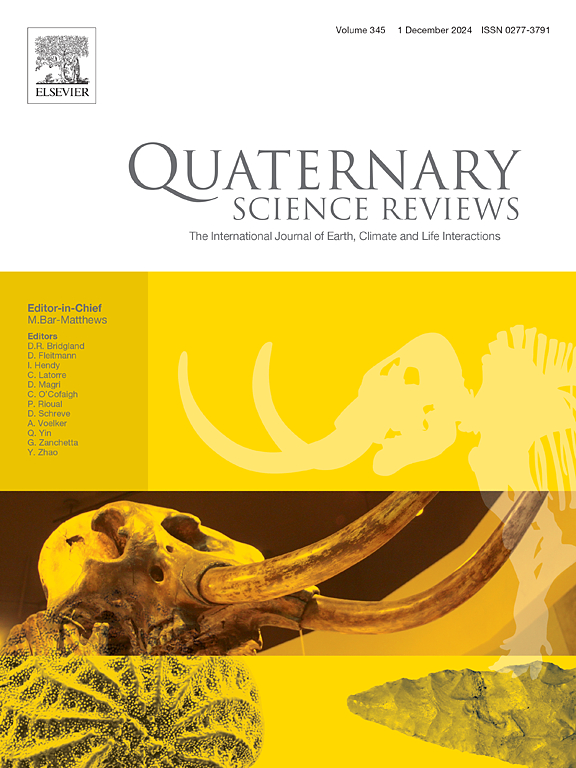菲律宾吕宋岛西北海岸的隆起、倾斜和底层结构,由海相阶地推断
IF 3.2
1区 地球科学
Q1 GEOGRAPHY, PHYSICAL
引用次数: 0
摘要
菲律宾吕宋岛北部位于巽他板块与菲律宾海板块交汇之间,是一个复杂构造背景下的地震活跃区。吕宋岛西北部沿海的更新世海相阶地残余物已经变形,为活跃的下伏构造提供了线索。通过遥感和实地调查,我们绘制和调查了吕宋岛西北海岸帕苏金市和圣多明各市之间的几代隆起的更新世海洋阶地。我们发现,波浪切割台地是该地区最常见的海相台地类型,每个台地都由沉积基底(老阿格组)和河流或冲积矿床盖层组成。这些阶地的抬升表明,老阿格城北部地区经历了向西倾斜,而更南部地区则均匀地抬升。利用k -长石红外激发发光(IRSL)测年技术对切波台地磨损面以上的砂样进行测年,推断出最突出的海相阶地形成于海洋同位素阶段(MIS) 5a,其向海边缘在平均海平面以上40 ~ 50 m。这表明,沿海地区的长期隆升速率为1米/凯尔,内陆地区的隆升速率高达1.6米/凯尔。结合野外调查证据、测深和震源机制数据,我们认为沿海地区的大规模隆升是沿东向逆冲断层滑动的结果,其表面迹线距西海岸约12公里,而维甘-阿高断裂带的西向分支导致了沿海地区的倾斜、水平(左旋)运动和局部褶皱。通过弹性位错模拟,我们认为海上断裂的倾角可能小于45°,南北隆升模式的差异可归因于两条断裂之间不同的滑动速率分布。总体而言,我们估计吕宋岛西北部近岸和沿海地区的西北偏西方向缩短为1-2 m/kyr。本文章由计算机程序翻译,如有差异,请以英文原文为准。
Uplift, tilting, and underlying structures of coastal northwestern Luzon, Philippines, deduced from marine terraces
Northern Luzon Island of the Philippines, located between the converging Sunda and Philippine Sea Plates, is a seismically active region within a complex tectonic setting. Remnants of Pleistocene marine terraces along the coast of northwestern Luzon have been deformed and provide clues to the active underlying structures. Through remote sensing and field surveys, we mapped and surveyed multiple generations of uplifted Pleistocene marine terraces between the municipalities of Pasuquin and Santo Domingo along the northwestern Luzon coast. We found that wave-cut platforms are the most common type of marine terrace in the area, each consisting of a sedimentary basement (Laoag Formation) and a fluvial or alluvial deposit cover. The uplift of these terraces shows that the area north of Laoag City has experienced westward tilting while the area farther south has been uniformly uplifted. With K-feldspar infrared stimulated luminescence (IRSL) dating of sand samples collected above the abrasion surface of the wave-cut platforms, we infer that the most prominent marine terrace, with a seaward edge 40–50 m above mean sea level, was formed during marine isotope stage (MIS) 5a. This suggests a long-term uplift rate of ∼1 m/kyr along the coast and up to 1.6 m/kyr farther inland. Combining evidence from field surveys and bathymetric and focal mechanism data, we suggest that the large-scale uplift of the coastal area is the result of slip along an east-dipping thrust with a surface trace ∼12 km off the west coast, while a west-dipping branch of the Vigan-Aggao Fault Zone has contributed to tilting, horizontal (sinistral) movement, and localized folding of the coastal area. Through elastic dislocation modeling, we suggest the offshore fault likely has a dip angle lower than 45°, and the difference in uplift patterns between north and south can be attributed to different slip-rate distributions between the two faults. Overall, we estimate west-northwest directed shortening at 1–2 m/kyr across the nearshore and coastal area of northwestern Luzon.
求助全文
通过发布文献求助,成功后即可免费获取论文全文。
去求助
来源期刊

Quaternary Science Reviews
地学-地球科学综合
CiteScore
7.50
自引率
15.00%
发文量
388
审稿时长
3 months
期刊介绍:
Quaternary Science Reviews caters for all aspects of Quaternary science, and includes, for example, geology, geomorphology, geography, archaeology, soil science, palaeobotany, palaeontology, palaeoclimatology and the full range of applicable dating methods. The dividing line between what constitutes the review paper and one which contains new original data is not easy to establish, so QSR also publishes papers with new data especially if these perform a review function. All the Quaternary sciences are changing rapidly and subject to re-evaluation as the pace of discovery quickens; thus the diverse but comprehensive role of Quaternary Science Reviews keeps readers abreast of the wider issues relating to new developments in the field.
 求助内容:
求助内容: 应助结果提醒方式:
应助结果提醒方式:


